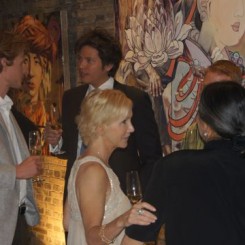Elisabeth de Brabant came to Shanghai in 2004 and soon began working in the then nascent M50 art district. In 2008 she established her own art advisory firm and gallery. Here de Brabant talks with Randian about growing up in a family of New York collectors, the nature of galleries and the problems of the China art market.
Editorial Note: The following transcript has been amended since publication.
Chris Moore: Elisabeth, thank you for agreeing to speak with Randian. Could you please start by giving us an idea of how you became involved in art and eventually setting up your firm?
Elisabeth de Brabant: Thank you to Randian for inviting me. I have been surrounded by great artworks all my life. I come from three generations of art collectors, art donors, and benefactors to such institutions as MoMA in New York, the Tate Modern, the Victoria & Albert Museum, and the Seattle Art Museum, to name a few. So I was brought up having a heightened sensibility to the environment. I went to Columbia University and graduated in art history and comparative literature, but I still felt frustrated as an artist. So I joined the Central St. Martin’s Masters Degree program. That was an amazing experience, but one that brought me to understand and feel that I was a better visual expert than artist.
I have always collected art and I have always been interested in museums — museum programming fascinated me. Philippe de Montebello, at the time the director of the Metropolitan Museum of New York, was a friend of the family and is well recognized for having revolutionized museum programming. So I probably developed the passion from that. I did some collecting and I pretty soon decided that I wanted to be the one in my family that actually got more involved with art, which happened when I arrived here.
CM: So when did you come to Shanghai?
EdeB: I came to Shanghai in 2004. I immediately was fascinated by the “cowboy” element of the Chinese contemporary art world in Beijing, Hangzhou, and Shanghai. These were the days of Zhou Tiehai, Yue Minjun, Zhang Huan, just to mention a few, who were really important pioneers of the Chinese contemporary art movement. There were very few art galleries at the time in China, and some of them were very inconsistent. As I began to collect my first pieces of Chinese contemporary art, I got involved with an auction for the American Women’s Club, which brought me into the Shanghai art scene. The auction was organized with Sami Wafa from Art Scene, and through that experience Sami became my business partner. I wanted to understand better what Chinese people considered “good” art, what the Chinese contemporary art movement was, and the financial value of it versus, say, the European or American contemporary collections that I had been brought up with.
CM: You avoid the tag of “art dealer” or “art gallery”; so how would you define what you do?
EdeB: I have to say that I have an allergy to art dealers or marchands d’art. There are people I have met who inspire me, and those are the individuals who are more intellectually passionate — more intuitively passionate — about what they do and how they can help, rather than just selling a product. Unfortunately, I think galleries internationally have become very much product-based, very much speculative, very much sick. It’s a personal issue. I come from a belief that art should be something that is cultural, a reflection of society and of our times.
